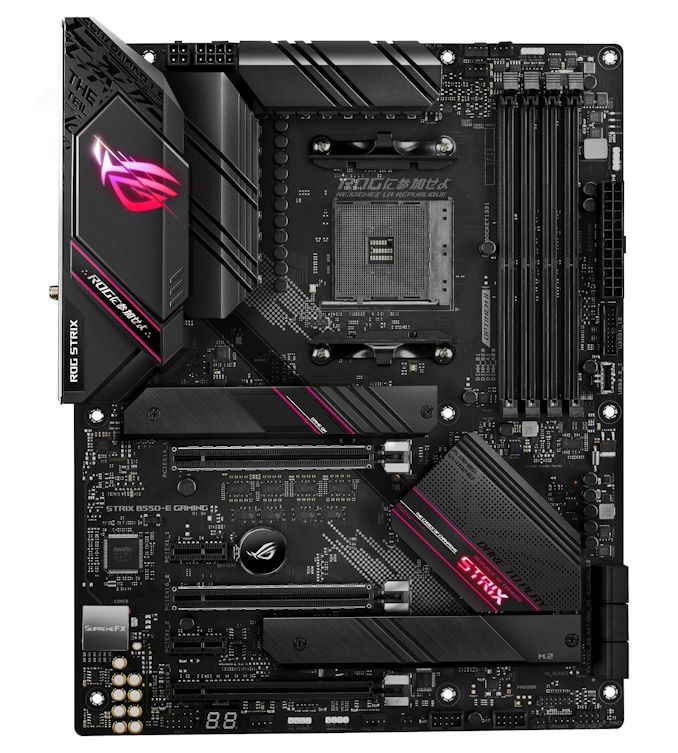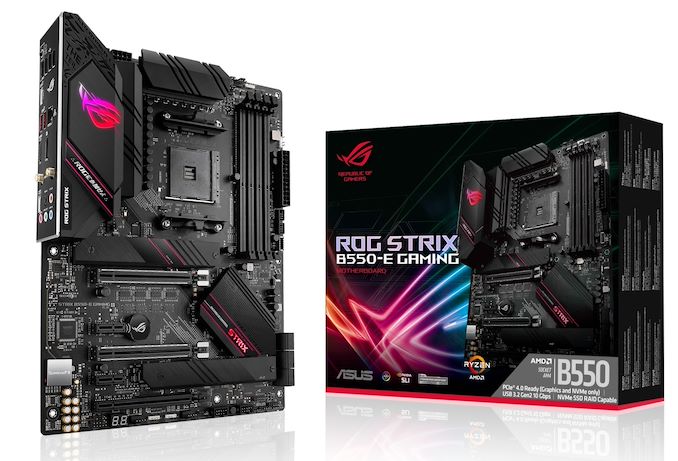The AMD B550 Motherboard Overview: ASUS, GIGABYTE, MSI, ASRock, and Others
by Dr. Ian Cutress & Gavin Bonshor on June 16, 2020 11:00 AM ESTASUS ROG Strix B550-E Gaming
Out of ASUS’ three main sub-brands for B550, the Strix is aimed at the higher end, and we get a range of options to play with. The B550-E Gaming is the more expensive of the bunch, at $280, although it is one of the few boards to offer x8/x8 functionality with its PCIe slots. The use of this configuration isn’t so much for gaming (despite the name), due to lack of SLI support, but it does enable a good setup for a machine based around GPU compute or add-in cards, like RAID cards, or additional PCIe x4 NVMe drives.
ASUS’ design philosophy this time around involves a similar corner to corner 45-degree line scheme to a lot of other different brands, however in parts ASUS pushes this to a more dot-matrix style design. We still get that ROG font on all the words though.
For features, the B550-E Gaming has a large rear panel cover that covers only the rear panel rather than the full audio section, and this covers over the heatsink for the power delivery. There are two heatsinks here, like most boards with high-end power delivery, but there does not seem to be a heatpipe between them for this board.
The socket area has access to four 4-pin fan headers within easy reach, three of which are just above and to the right of the socket. The CPU is powered by an 8-pin and a 4-pin, and the board has four memory slots with single sided latch arrangements. Down the right hand side of the board is a 4-pin LED header, a 24-pin ATX power connector, a USB 3.0 header, a Type-C header, and six SATA ports.
For the PCIe area, as mentioned the two main PCIe slots both come from the CPU, with x16 or x8/x8 connectivity at PCIe 4.0 bandwidth, due to the use of PCIe switches. Both of the main PCIe slots have extra reinforcement, and above the first PCIe slot is a PCIe 4.0 x4 M.2 slot, with its own heatsink. This isn’t connected directly to the chipset heatsink, however the second M.2 slot (a PCIe 3.0 x4 from the chipset) is connected. The final full-length PCIe slot is a PCIe 3.0 x4 from the chipset as well.
Along the bottom of the board is a 2-digit debug, two 4-pin fan headers, two RGB LED headers, two USB 2.0 headers, and the front panel headers. The audio codec on the left, ASUS’ custom S1200A codec, gets the SupremeFX treatment.
On the rear panel there is a 2.5 gigabit Ethernet port (Intel I225-V), a DisplayPort, a HDMI video output, two Type-A USB 3.2 Gen 2 ports, one Type-C USB 3.2 Gen 2 port, four USB 2.0 ports, one USB 2.0 Type-C port for audio, audio jacks, a BIOS Flashback button, and an Intel AX200 Wi-Fi 6 module.













101 Comments
View All Comments
Kougar - Tuesday, June 16, 2020 - link
Most of these boards are a serious VRM upgrade over the B450 boards. If I was buying Ryzen right now I'd easily go B550 over X570.So, only the ASUS boards offer bios flashback? Seems like a cheaper, just as userful version of dual BIOS anyway.
Brane2 - Tuesday, June 16, 2020 - link
Finally ONE mini-ITX board with 3-monitor output.Gigaplex - Tuesday, June 16, 2020 - link
Colour me disappointed. I was hoping to do a mATX file server build using an APU. No support for existing APUs, no ETA on when consumers can buy the newer APUs, and most of these boards only have 4 SATA ports.I really don't want to have to buy a crappy NVIDIA 710 just to get it running.
mm0zct - Wednesday, June 17, 2020 - link
If you're booting Linux, you might be able to get away with either a good old fashioned serial cable (a lot of boards still have a serial port header) or a USB-HDMI/VGA dongle, since these are supported by the mainline kernel. The main issue might jus tbe getting the BIOS to boot your install media, but a serial port might work still here.You could also just borrow a graphics card from any other system you own to do the initial install, and then let it run headlessly once it's up and running.
Gigaplex - Wednesday, June 17, 2020 - link
I am booting Linux, and have tried completely headless in the past. It's not really worth the trouble (especially if I need to quickly diagnose issues), I'd rather just buy the crappy GPU.IBM760XL - Tuesday, June 16, 2020 - link
I'm probably missing something, but what's the point of including HDMI/DP/DVI outputs if the boards don't support APUs? Aren't you going to need to use the output on your dGPU anyway?I appreciate the summaries on the last page, but wish it could be enhanced a bit. E.g. what's the cheapest board with 2.5G Ethernet? What are the cheapest boards in general? I probably wouldn't go with the cheapest one, but given the prices on a lot of these, it's likely I would choose one of the less expensive ones.
Gigaplex - Wednesday, June 17, 2020 - link
They will support the Zen 2 APUs, which aren't out yet.IBM760XL - Tuesday, June 16, 2020 - link
So checking my local store's inventory, they have 25 B550 boards in stock, of all varieties, but are completely sold out of both B450 and X570 (there are a few cheap A320 boards available as well, and nine TRX40 boards that start at $450).Something tells me Ryzen 3000 chips have been selling quicker than the motherboard manufacturers can keep up, and maybe that's part of the reason B550 prices are starting out high. If they're selling out, it makes sense for them to start with a higher MSRP, which they can always lower if demand falls.
Unfortunately for AMD, if B450 doesn't come back in stock, that's going to hurt Ryzen 3000 sales. Intel mobo inventory is also a bit limited, but about half of the Intel models they offer are available, including some in that $75-$125 range, versus about 15% of the AMD models being in stock currently.
romrunning - Wednesday, June 17, 2020 - link
I think the delays are all shipping-related. It's affecting all computer parts, like power supplies, motherboards, and the like. I wish a bunch of the mfgs would just pool resources to buy dedicated air cargo flights; maybe pooling will mitigate some of the losses on the lower margin items.Oxford Guy - Tuesday, June 16, 2020 - link
"Most of these boards are a serious VRM upgrade over the B450 boards. If I was buying Ryzen right now I'd easily go B550 over X570."Why does that matter? Overclocking died with Zen, especially Zen 2.
As long as it doesn't throttle, you're good.